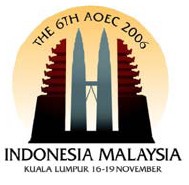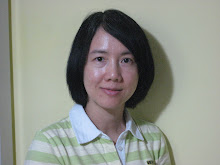6th Asian & Oceanian Epilepsy Congress
Feedback on Asian Epilepsy Congress (AOEC)
6TH ASIAN & OCEANIAN EPILEPSY CONGRESS (AOEC) (AOEA - PATIENT PROGRAMME) 15TH NOVEMBER - 17TH NOVEMBER 2006
Written by: Serene Low
First and foremost, I would like to say "Thank You" or "Terima Kasih to Persatuan Epilepsi Malaysia and UCB Pharma Asia Pacific Sdn Bhd for giving me an opportunity of a lifetime to attend epilepsy patient programmes organised in conjunction with the above congress. I was one of seven privileged Malaysian participants to have attended AOEA. Of the seven participants, six of us met on 4th November, a Saturday afternoon, to brief and discuss what AOEA is about.
Day 1
On 15th November, seven of us turned up at KLCC Convention Centre to register for AOEA. Upon registration we were given our name tags and bags containing materials relevant to our programmes. Most of us quickly browsed through the materials and then we adjourned to a food court which is located on the 4th floor of KLCC Convention Centre. We had some light refreshment while waiting for the first event of AOEA to start.
At 6.30pm, we congregated at the main entrance of KLCC Convention Centre (on the Jalan Pinang side) together with participants from Singapore, India, Indonesia, Taiwan, Mongolia, Hong Kong, Japan, Philippines and Thailand. There was a huge crowd of participants and within minutes, we were quickly ushered into coaches waiting to take us to Lake Titiwangsa.
At Lake Titiwangsa, all participants were being directed to Nelayan Restaurant. At 8.00pm, Persatuan Epilepsi Malaysia's president, Dr Hussain Imam Mohammad Ismail gave a short welcome speech and wish all of us "Happy Dinner". I sat at a table together with Taiwanese and Singaporeans. While enjoying our dinner, we quickly introduced ourselves and exchanged name cards. The main language used by the participants at our table was Chinese. Although I am an English educated person, I was able to mix well and spoke Chinese with my foreign friends. We were a happy group of friends and we also enjoyed our food a lot. We left Lake Titiwangsa at about 9.45pm and returned to KLCC Convention Centre at 10.15pm.

Serene Low (center) with four of her Malaysian delegates

Informal welcome dinner with Singaporean delegates
Day 2
This was our most tiring day of AOEA. Talks started at 9.00am and ended at 5.30pm. In between talks we had two coffee breaks and a delicious buffet lunch.
Patients and caregivers participated actively with questions that were tactfully answered by panels of invited doctors. I especially liked the programme concerning "Outstanding Persons With Epilepsy" from six countries. These people gave testimonies on their encounter with epilepsy and conquering it. I was very motivated and touched by their stories. An epilepsy patient myself, I can feel and understand these peoples' emotions and problems better than non sufferers.
Another programme I appreciated a lot was the two DVD presentations. The first DVD show was presented by the Taiwan Epilepsy Association entitled "The Moment I Lost Myself" followed by the second show presented by Hong Kong Epilepsy Society entitled "Demystifying Epilepsy - Educational Kit on Epilepsy".
At 6.00pm we witnessed the opening ceremony of the 6th AOEC. The first speaker was IBE President, Susanne Lund followed by four more speakers who gave their short welcome speeches. After the speeches there was a local dance performance organised by the Malaysia Tourism Board. My Taiwanese and Singaporean friends were impressed with the dances and the dancers' colourful and beautiful costumes.
At 7.00pm all delegates and participants were given a welcome reception. We all had a sumptuous dinner and went home feeling tired but happy with all the useful knowledge we had acquired throughout the day.

Welcoming delegates on behalf of host country (Malaysia)
Day 3
After a long and tiring day yesterday, we all looked forward to this day of social outing. Coaches picked us up at 10.00am at the KLCC Convention Centre's main entrance and left for Putrajaya (the new Malaysian capital).
Ms Jennifer Chen, president of the Taiwan Epilepsy Association sat beside me. We exchanged information concerning epilepsy on an NGO level as well as personal level. By this day, both of us had become good friends. I am very glad to have found another new friend as a resulf of attending AOEA.
We arrived at Putrajaya slightly past eleven and walked a short distance to board air-conditioned tour boats for a cruise around Putrajaya Lake. It was my first time to cruise round Putrajaya Lake and the sights and views of Putrajaya buildings (mosque, bridge, government offices and hospital) were beautiful and artistic. We also had a guide in our boat who explained to us briefly about the sights surrounding us.
After the cruise, we were treated to a buffet lunch in a restaurant by the Lake. It was a nice experience to be able to enjoy our lunch comfortably and at the same time surrounded by beautiful scenery. At around 2.00pm we boarded the coach for a short tour around Putrajaya taking in more wonderful sights. We returned to KLCC Convention Centre at approximately 4.45pm.
At KLCC, the Taiwanese participants invited me to join them for some last minute shopping at the mall. We had a great time together.

Boat cruise at Putrajaya with fellow delegates
Having attended AOEA for the first time, I hope to be able to attend future conventions/conferences related to epilepsy. AOEA has enriched my life and taught me how to continue in my pursuit to achieve better ways of assisting my epileptic friends in Persatuan Epilepsi Malaysia.
 Final group photo
Final group photo
Related Link:
Children With Disability blog
















































